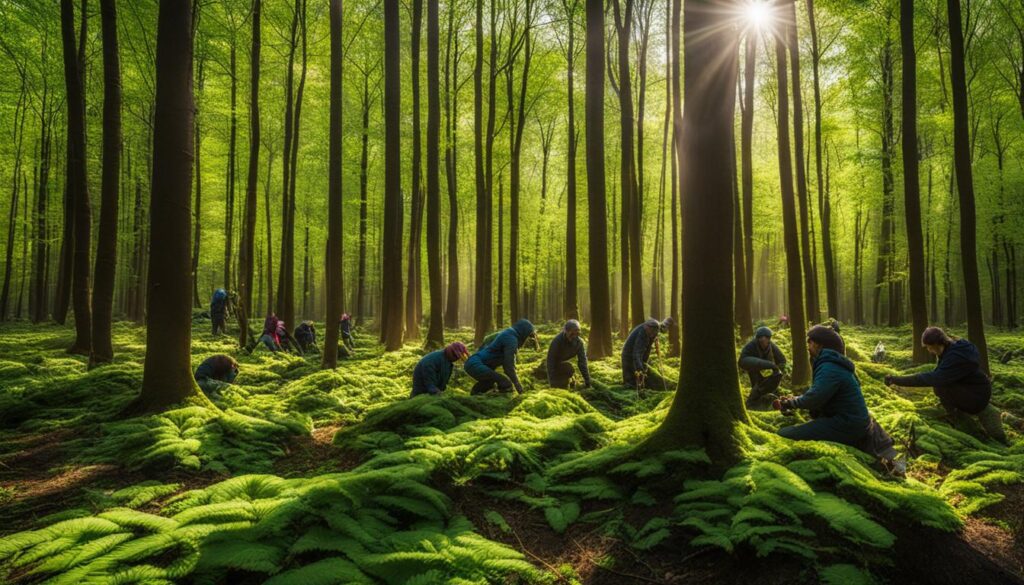Restoring forests and planting trees has become increasingly important in the face of climate change and biodiversity loss. The urgency of these issues has led to a surge in tree planting initiatives and organizations worldwide. However, understanding the cost to plant a tree and the factors that influence prices is crucial for effective planning and investment in green initiatives. In this article, we will explore the various aspects of the cost to plant a tree, providing insights and revealing the prices associated with tree planting projects.
Key Takeaways:
- The cost to plant a tree can vary depending on multiple factors.
- Factors influencing tree planting costs include tree species, site preparation, number of trees to be planted, and maintenance needs.
- Tree planting prices may also depend on location, labor, and equipment costs.
- It is important to consider long-term maintenance and management costs when calculating the true cost of tree planting projects.
- Proper budget allocation and investment in high-quality restoration projects are essential for achieving long-term environmental impact.
The Importance of Tree Planting in Restoring Forests
The global community has recognized the significance of tree planting in addressing environmental challenges such as climate change and biodiversity loss. Initiatives like the Glasgow Leaders’ Declaration on Forests and Land Use and the Bonn Challenge have set ambitious goals to end and reverse forest loss and degradation.
Tree planting offers a tangible action for individuals, organizations, and governments to engage in climate action and contribute to ecosystem restoration. By planting trees, we can actively mitigate climate change, as forests act as carbon sinks, absorbing and storing carbon dioxide from the atmosphere. Furthermore, forests play a crucial role in preserving biodiversity, providing habitats for numerous plant and animal species.
However, it is essential to ensure that tree planting efforts focus on effective ecosystem restoration and deliver lasting benefits for people, nature, and the climate. Restoration projects must consider not only the quantity but also the quality of trees planted, as well as the appropriate selection of species for the specific ecosystem.
Image:
Restoring forests through tree planting is a multifaceted approach that goes beyond combating climate change. It also contributes to soil conservation, water cycle regulation, and sustainable land management. Forests provide essential ecosystem services, including air and water purification, soil stabilization, and flood control.
Moreover, forest restoration efforts help enhance resilience against natural disasters and provide economic opportunities through sustainable forest management and ecotourism. By promoting the restoration of degraded lands and the protection of existing forests, we can maintain vital ecological systems and improve the overall well-being of communities.
To achieve successful forest restoration and maximize the benefits of tree planting, collaboration between stakeholders is crucial. Governments, non-governmental organizations, and local communities must work together to ensure proper planning, implementation, and long-term management of these restoration projects.
Climate Change Mitigation and Biodiversity Conservation
Tree planting plays a significant role in climate change mitigation by sequestering carbon dioxide through the process of photosynthesis. Trees absorb carbon dioxide from the atmosphere, releasing oxygen and storing carbon in their wood and branches. Through this process, forests act as natural carbon sinks, helping to reduce greenhouse gas emissions and combat global warming.
Furthermore, forests are vital for biodiversity conservation by providing habitats for a wide range of plant and animal species. Forest ecosystems support diverse food chains, contributing to the overall balance of ecosystems and the preservation of biological diversity.
Therefore, tree planting initiatives that prioritize forest restoration contribute not only to climate action but also to the preservation of our planet’s rich biodiversity.
Understanding the True Cost of Tree Planting
While tree planting has gained popularity, it is crucial to fully comprehend the true cost involved in these projects. Many organizations market tree planting at a low cost per tree, but effective ecosystem restoration requires a more holistic approach. Factors such as good quality restoration, cost considerations, and budget allocation play a significant role in determining the actual cost of planting trees.
When estimating tree planting costs, it is essential to consider various elements. These can include the procurement of high-quality seedlings, site preparation, labor, transportation, and ongoing maintenance. A thorough assessment of these factors will help provide a comprehensive understanding of the overall expenses involved in a tree planting project.
Investing in restoration projects requires wise budget considerations. While it may be tempting to opt for the cheapest options, it is crucial to prioritize quality and long-term sustainability. Allocating an adequate budget ensures that the necessary resources and expertise are available, leading to successful and impactful restoration efforts.
Additionally, the long-term maintenance and management of restoration sites greatly contribute to the overall cost. Regular monitoring, watering, weed control, and pest management are essential to ensure the survival and growth of newly planted trees. Proper resourcing and funding are necessary to support these measures and guarantee the successful establishment of the restoration project.
Evaluating the Effectiveness of Tree Planting Initiatives
To assess the effectiveness of tree planting initiatives, it is essential to conduct a thorough review of relevant scientific literature. The scientific literature review provides valuable insights into the outcomes of tree planting projects and the strength of the evidence supporting their conservation effectiveness.
Impact on Environmental Goals
Studies have examined the impact of tree planting on various environmental goals, including carbon sequestration, water cycle regulation, and biodiversity conservation. These research findings help in understanding the true potential of tree planting initiatives in achieving environmental sustainability.
For example, scientific studies have shown that tree planting can significantly contribute to carbon sequestration, the process of capturing and storing carbon dioxide from the atmosphere. By absorbing CO2 through photosynthesis, trees help mitigate climate change by reducing greenhouse gas emissions.
Furthermore, tree planting plays a crucial role in regulating water cycles, helping prevent soil erosion, and improving water quality. The intricate root systems of trees help retain water, reducing the risk of flooding during heavy rainfall and supporting natural water filtration processes.
In terms of biodiversity conservation, tree planting can provide new habitats for various species, enhance ecosystem resilience, and contribute to the preservation of critical wildlife corridors. Restoring forests and planting native tree species can help reestablish ecologically balanced ecosystems, supporting the survival of diverse plant and animal species.
Informed Decision Making
By understanding the science behind tree planting and reviewing the relevant literature, organizations and individuals can make informed decisions about investing in these initiatives. The scientific evidence strengthens the case for tree planting by showcasing its potential in achieving specific environmental goals.
Furthermore, a scientific literature review enables stakeholders to measure the environmental impact accurately. It provides a framework for evaluating the effectiveness of tree planting projects, identifying best practices, and optimizing strategies for maximum conservation effectiveness.
Ultimately, evaluating the effectiveness of tree planting initiatives through scientific literature review helps guide the development of future projects, ensuring that resources are invested strategically to achieve long-term environmental benefits.
Evaluating the Success and Failures of Tree Planting Campaigns
Successful tree planting campaigns have played a crucial role in restoring forests and achieving their environmental goals. Notable examples include the Green Belt Movement in Kenya, which has successfully mobilized communities to plant trees and promote sustainable land use practices, and government-led initiatives like the Great Green Wall in Africa that aim to combat desertification and improve rural livelihoods through tree planting.
However, it is important to acknowledge that not all tree planting efforts have been equally successful. Several factors contribute to the failure of reforestation projects, such as a lack of consideration for local conditions, inadequate planning, or a sole focus on planting a high number of trees without ensuring proper care and maintenance.
To maximize the effectiveness of tree planting campaigns, it is crucial to understand and address the factors that influence their outcomes. Local environmental conditions, including soil quality, water availability, and appropriate tree species selection, play a significant role in determining the success of tree planting projects. Additionally, community engagement, proper planning and monitoring, and long-term maintenance are essential to ensure the survival and growth of planted trees.
Evaluating both successful and failed tree planting campaigns provides valuable insights for future initiatives. By learning from past experiences and implementing effective strategies, we can ensure positive outcomes and contribute to the long-term restoration and conservation of our precious forests.
Conclusion
Tree planting is a crucial strategy for restoring forests and combating the adverse effects of climate change. To maximize the long-term environmental impact, it is essential to understand the true cost of tree planting and invest in high-quality restoration projects. By evaluating the effectiveness of both successful and failed tree planting campaigns, we can gain valuable insights to guide the development of strategic initiatives.
When considering tree planting strategies, it is important to allocate sufficient budget for the project. Proper resourcing ensures that the planting and maintenance processes are executed effectively, leading to successful outcomes. Additionally, long-term maintenance must be taken into account to ensure the sustained growth and survival of the planted trees.
Furthermore, a thorough understanding of the scientific principles behind tree planting is crucial. By leveraging scientific knowledge, individuals, organizations, and governments can make informed decisions and contribute to effective green investments. Scientific literature reviews provide valuable insights into the outcomes and environmental benefits of tree planting projects, allowing for accurate measurement of their long-term impact.
In conclusion, by implementing strategic tree planting initiatives guided by factors such as budget allocation, long-term maintenance, and scientific knowledge, we can achieve effective green investments. Through these efforts, we can contribute to the restoration of forests, combat climate change, and create a positive long-term environmental impact.
What is the Cost of Planting Trees Compared to Using Pea Gravel in Landscaping?
When considering landscaping options, it’s essential to compare pea gravel pricing and buying with the cost of planting trees. While pea gravel may seem more affordable upfront, the long-term benefits of trees, such as improved air quality and energy savings, make them a cost-effective option in the long run.
FAQ
What is the cost to plant a tree?
The cost to plant a tree can vary depending on various factors such as the location, tree species, project scale, and restoration goals. It is essential to conduct a thorough cost analysis and consider factors such as site preparation, tree sourcing, planting techniques, and long-term maintenance to accurately estimate the cost.
What factors influence tree planting costs?
Several factors can influence tree planting costs, including site preparation, tree sourcing and transportation, planting techniques, long-term maintenance, and monitoring. Additionally, factors such as local labor wages, equipment costs, and project scale can also contribute to the overall cost of tree planting projects.
How can I estimate the cost of tree planting?
To estimate the cost of tree planting, it is essential to consider factors such as the number of trees to be planted, the specific requirements for tree species and site preparation, labor and equipment costs, and ongoing maintenance and monitoring expenses. Consulting with experts and conducting a comprehensive cost analysis can help in estimating the expenses accurately.
What is the importance of tree planting in restoring forests?
Tree planting plays a vital role in restoring forests by helping to combat climate change and preserve biodiversity. Trees absorb carbon dioxide, a greenhouse gas that contributes to global warming, and provide habitat for numerous species. Restoring forests through tree planting also helps enhance water quality, mitigate natural disasters, and provide socioeconomic benefits to local communities.
How can tree planting contribute to climate change mitigation?
Tree planting contributes to climate change mitigation by absorbing and storing carbon dioxide through the process of photosynthesis. Trees act as carbon sinks, helping to reduce the amount of greenhouse gases in the atmosphere. By increasing forest cover and promoting reforestation efforts, tree planting plays a vital role in mitigating climate change.
What factors should be considered when evaluating tree planting initiatives?
When evaluating tree planting initiatives, factors such as the project’s environmental goals, scientific evidence supporting its effectiveness, community engagement, long-term maintenance plans, and monitoring mechanisms should be considered. Assessing these factors helps determine the overall success and impact of tree planting projects.
What can we learn from successful tree planting campaigns?
Successful tree planting campaigns provide valuable insights into effective strategies for restoring forests. They highlight the importance of considering local conditions, engaging communities, implementing proper planning and maintenance, and aligning with scientific evidence. Learning from successful campaigns can guide the development of future initiatives and ensure positive outcomes.
What are the factors that contribute to the success or failure of tree planting campaigns?
Several factors can contribute to the success or failure of tree planting campaigns. These include considering local conditions, such as soil type and climate, implementing proper site preparation and tree selection, ensuring community participation and support, effective long-term maintenance and monitoring, and aligning with scientific evidence and best practices. Ignoring these factors can lead to the failure of tree planting efforts.











